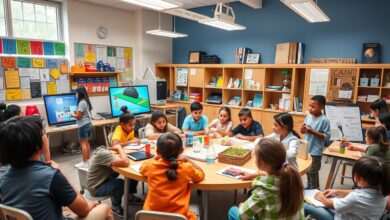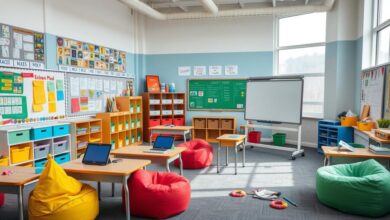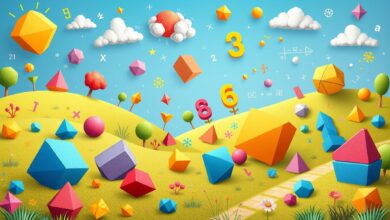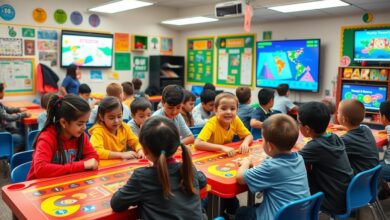Modern Teaching Strategies: Improve Student Learning Outcomes
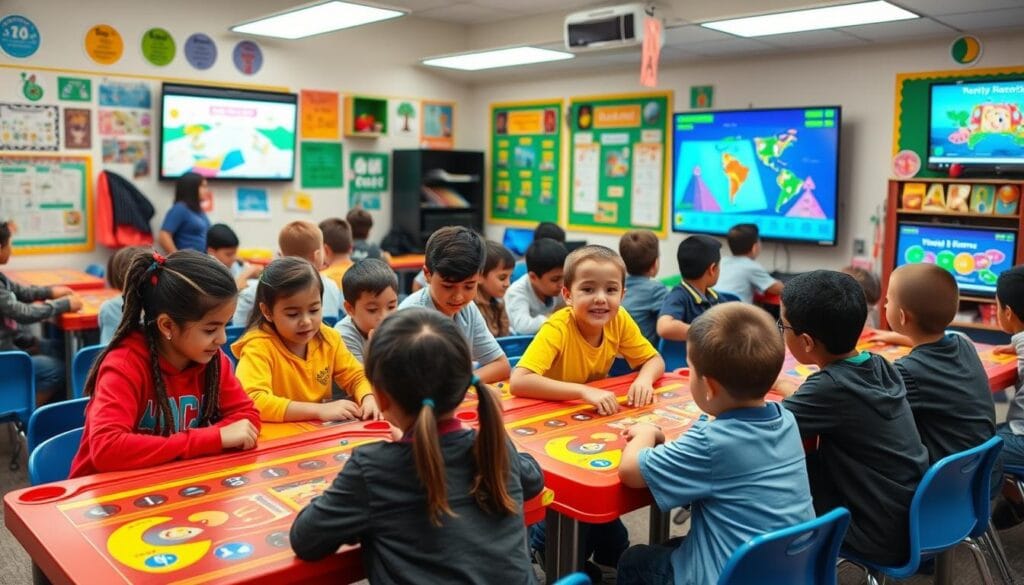
Table of Contents
Developing education is a top priority at this time. Educational strategies are very important for improving student outcomes. This article highlights effective ways teachers can follow to improve study outcomes.
Modern educational strategies require deep knowledge of student needs. By focusing on interactive learning, teachers can create a productive learning environment. This environment significantly helps in improving learning outcomes.
Concept of Educational Strategies and Their Importance in Modern Education
Understanding educational strategies is very important in modern education development. These strategies help teachers achieve their goals and ensure education quality.
Definition of Educational Strategies
Educational strategies are a set of organized plans and methods that teachers use. They help achieve desired educational outcomes. They include:
- Designing an active learning environment
- Choosing appropriate teaching methods
- Developing effective assessment methods
Role of Strategies in Improving Education Quality
Educational strategies are very important in improving education quality. They help in:
- Stimulating effective student participation
- Enhancing critical thinking skills
- Adapting education to each student’s needs
Impact of Strategies on Student Achievement
Innovative educational strategies help improve student achievement. They help create an interactive and enjoyable learning environment. This environment motivates students to research and explore.
“Good educational strategies are the key to educational success.”
Active Learning as a Core for Educational Development

Active learning is a teaching method that encourages active student participation. This approach aims to transform the student from a passive recipient to an active participant. This improves their classroom experience.
- Increased focus and effective student participation
- Development of critical and creative thinking skills
- Enhanced ability to solve problems independently
Teachers can use various strategies to achieve educational development. The goal is to create a learning environment that encourages interaction and participation.
Active learning is not just a teaching method; it’s a comprehensive approach that focuses on the student as a core element in the educational process.
Studies show that active learning significantly improves learning outcomes. This helps students to:
- Understand educational content more deeply
- Develop communication skills
- Build self-confidence
| Active Learning Strategy | Expected Outcomes |
|---|---|
| Interactive discussions | Increased student participation |
| Group problem-solving | Development of teamwork skills |
| Project-based learning | Enhancement of creativity and innovation |
By focusing on active learning, educational institutions can achieve comprehensive educational development. This meets the needs of students in the modern era.
Cooperative Learning Strategies and Their Applications in the Classroom

Cooperative learning is a powerful educational strategy. It helps students develop teamwork skills. It creates a collaborative learning environment that encourages interaction and shared learning.
Organizing Learning Groups
Organizing cooperative learning groups requires essential steps:
- Dividing students into balanced groups
- Defining clear roles for each member
- Setting common goals for the group
Techniques for Managing Group Work
Effective group work management requires:
- Continuous communication among group members
- Encouraging active participation
- Providing direct feedback
Evaluating Cooperative Learning Outcomes
Cooperative learning can be evaluated through:
| Assessment Criteria | Description |
|---|---|
| Individual performance | Evaluating each student’s contribution |
| Group results | Evaluating the team’s overall achievements |
| Cooperative skills | Measuring the ability to work in a group |
“Success in cooperative learning depends on effective interaction and communication among students.”
Modern Technology in Service of the Educational Process

Technology in education significantly changes the educational landscape. Digital educational media has become an effective tool for improving learning. It helps make the experience better for both students and teachers.
- Advanced e-learning platforms
- Interactive educational applications
- Remote communication and collaboration tools
- Smart assessment programs
These tools offer numerous benefits for education:
| Technological Tool | Educational Benefits |
|---|---|
| E-learning platforms | Facilitating access to educational content |
| Interactive applications | Increasing student interaction and participation |
| Digital assessment tools | Analyzing performance instantly and accurately |
Educational experts say that integrating technology into education opens new horizons for innovative and interactive learning.
It is important for teachers to focus on the smart use of technology. Technology should help achieve educational goals. Technology is not a substitute for the teacher, but an aid to improve the quality of education.
Continuous Assessment Methods and Measurement of Learning Outcomes

Continuous assessment is an essential part of educational development. It helps teachers accurately understand student levels. It also shows strengths and weaknesses in learning.
Effective Assessment Tools
There are many tools for measuring learning outcomes. These include:
- Diagnostic tests
- Research projects
- Classroom observation
- Student self-assessment
Analyzing Assessment Results
Analyzing assessment results requires precise steps. This is to ensure maximum benefit from the data.
| Assessment Tool | Objective | Expected Results |
|---|---|---|
| Standardized tests | Measuring general level | Identifying learning gaps |
| Practical projects | Assessing applied skills | Measuring creative abilities |
Feedback and Performance Development
Feedback is very important in improving education. It helps students and teachers to:
- Identify areas for improvement
- Reinforce positive practices
- Develop individual learning strategies
“Continuous assessment is not just a test, but a comprehensive process for understanding and developing learning abilities.”
Thanks to continuous assessment, learning outcomes can be significantly improved. The quality of the educational process also improves.
Lesson Planning Using Diverse Strategies
Lesson planning is very important in education. Educational design should be flexible and include diverse strategies. These strategies help meet the needs of every student.
- Clearly understanding learning objectives
- Identifying different student needs
- Choosing appropriate teaching strategies
Using diverse strategies leads to:
- Increased classroom interaction
- Improved student understanding
- Increased motivation for learning
“Success in teaching lies in the ability to adapt and diversify educational methods.”
Methods such as cooperative learning, active learning, and digital learning can be integrated. This helps achieve the best results in education.
Motivating Students and Building Learning Drive
Motivating students is very important for their success in school. Motivation for learning helps improve their academic results and develop their personal skills.
Effective Motivation Strategies
There are several ways to motivate students:
- Focusing on individual achievements and acknowledging efforts
- Using positive reinforcement techniques
- Connecting learning to personal goals
- Encouraging active participation in class
Creating a Motivating Learning Environment
To create a motivating learning environment, focus on:
| Element | Description |
|---|---|
| Positive communication | Building supportive relationships between teacher and student |
| Educational flexibility | Providing diverse learning methods to suit different styles |
| Continuous encouragement | Boosting self-confidence and inspiring academic ambition |
Motivation for learning is the true key to achieving educational excellence.
You can motivate your students by understanding their individual needs. Also, create a supportive and encouraging environment for continuous learning.
Conclusion
Using good educational strategies is fundamental to improving education. As a teacher, you can make a big difference in students’ experiences. Choose innovative teaching methods that meet each student’s needs.
To improve your teaching skills, you must commit to learning and renewing. This helps create an interactive learning environment. This environment encourages students to be creative and think critically.
Always explore new ways to use technology in education. The more flexible you become in using strategies, the better your ability to meet student needs.
Remember, effective education is a journey of development and innovation. Your goal is to inspire and empower future generations to learn and grow.
Frequently Asked Questions (FAQ)
What are the most effective educational strategies for improving learning outcomes?
Effective strategies include active learning and cooperative learning. Modern technology and continuous assessment are also used. These methods help engage students and improve their participation.
How can teachers implement active learning in the classroom?
Interactive activities such as group discussions can be used. Student presentations and collaborative problem-solving can also be used. Modern technology also helps with positive participation.
What is the importance of cooperative learning in improving learning outcomes?
Cooperative learning develops communication and teamwork skills. It allows for the exchange of ideas and deeper understanding. It also enhances social intelligence and improves learning abilities.
How can modern technology be integrated into educational strategies?
Technology can be integrated through e-learning platforms. Interactive applications and virtual classrooms are also used. These tools make education more engaging.
What is the importance of continuous assessment in improving learning outcomes?
Continuous assessment identifies strengths and weaknesses. It provides immediate feedback and adjusts strategies. This helps improve educational performance.
How can students be motivated to learn?
Students can be motivated by creating a positive learning environment. Content should be linked to practical life. Providing intangible rewards and using diverse, engaging methods also helps.
